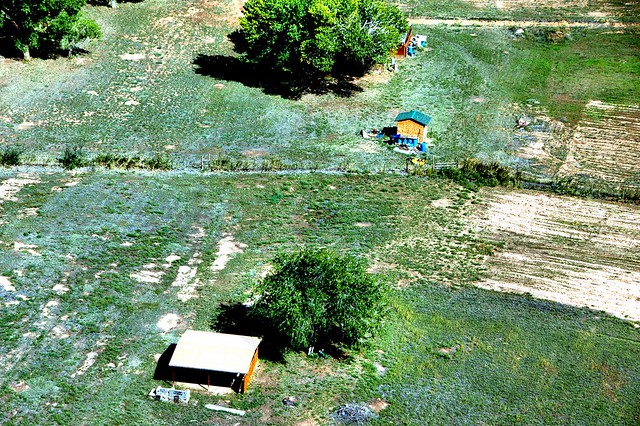The sign is clear and unequivocal: Private Property. No Photography. The area behind the sign is empty. There are no buildings, no livestock. What doesn’t the landowner want you to see? As you follow the chain link fence towards White House Ruin, stands of cottonwoods and green brush block the view. Glimpses through the trees reveal that there is something there — a house or a barn. You continue on to the ruin where you meet vendors selling jewelry and crafts. On the way back, you see other tourists photographing the sign.
Many national parks and monuments contain private land, some more than others; so Canyon de Chelly is not unique. Some overlooks (such as the one above) let you look down into the lives of the farmers and sheep herders who make the canyons their home. You might ask “What is the problem?”
The experience of the nearby Hopi gives some clue. Early Hopi were concerned that cameras stole their souls because of a mistranslation by a pioneer photographer. But this does not drive the ban on the reservation today. Outsiders annoy the residents of the Three Mesas by staring and pointing their fingers. Who wouldn’t be irked by this, I have to ask. Beyond the Mesas blogger Matthew Sakiestewa Gilbert puts it like this:
Imagine that you live in a remote area of North America that receives thousands of tourists each year. Your house is unlike most homes in the United States. It is made of sandstones and situated close to a highway. Throughout the year tourists zoom by your house, abruptly stop their cars, roll down their windows, and snap photos of your home. Sometimes this happens when you are sitting out front drinking ice tea and visiting with members of your family. Other times your children are playing outside. But it does not matter to the tourists if anyone is home, or whether people are outside. All they want is a photo of your home, and to them, the photo is only enhanced if you and your children are part of it. You sometimes wonder what people do with these photos. You imagine that some people put the picture of your home in a photo album, a book, make postcards and calendars from it, or sell it.
Concerned about your family’s privacy, you decide that enough is enough and so you put a sign in your front yard that reads: “Please do not take photos of my home.” And then you wait. It does not take long for the next tourist to drive by. He slows down. He reads the sign, then looks at your home, then reads the sign again. A Nikon camera is laying on the passenger seat. He finds himself in a dilemma, but he decides to honor your request. Five minutes later, another car approaches your home. These people stop and read your sign, then look around to see if anyone is looking, roll down their window, take several photos of your home and speed away. This happens day after day and it will only increase during the summer months.
Residents of other homes in the United States feel the same pressure. Consider the famous row of “painted ladies” in San Francisco. Photographers come from all over the world to capture these monuments to Victorian residential architecture. Some, however, go a step farther and take pictures of the residents as they try to go about their lives. Here the homeowners tolerate the taking pictures of their home, but the invasions of their privacy go just too far.
Thomas Zickgraf, 41, said, “Living here feels like Disneyland at times. Everyone’s outside taking photos and looking at the house, so you feel like you’re inside an attraction.”
While it’s not clear if that’s the reason for the reduced selling price, The San Francisco Chronicle seems to think so: “Maybe buying a piece of San Francisco history isn’t that appealing if thousands of tourists are taking a picture of your front door every day,” the newspaper writes.
Tourists can be arrogant when it comes to getting the photograph. The experience itself is not enough. So they photograph mountains, deserts, pretty girls at the beach with a mind to bring home trophies. The problem at Canyon de Chelly and the surrounding reservation lands is that the trophies often include human beings who just want to live their lives without being turned into museum exhibits.


